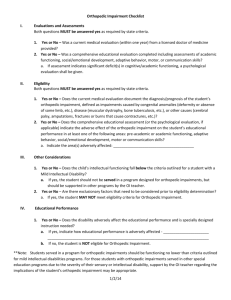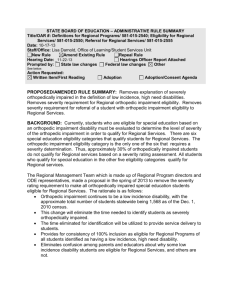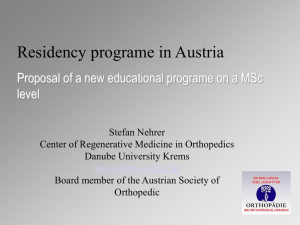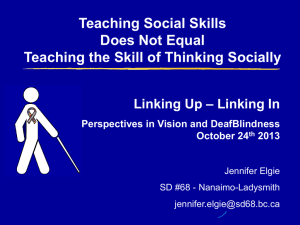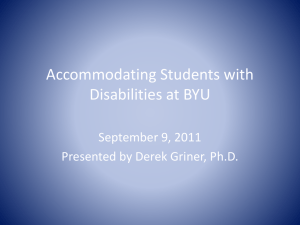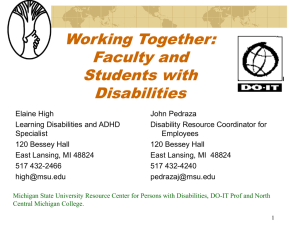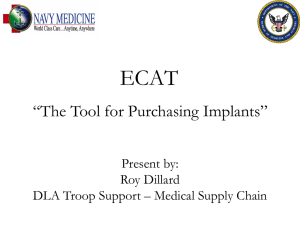Eligibility of a Child with Orthopedic Impairment
advertisement
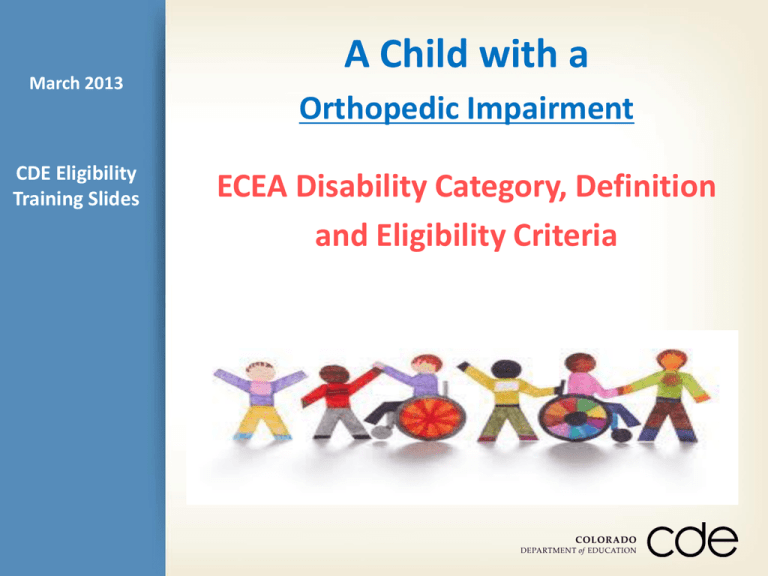
March 2013 CDE Eligibility Training Slides A Child with a Orthopedic Impairment ECEA Disability Category, Definition and Eligibility Criteria Together We Can Vision All students in Colorado will become educated and productive citizens capable of succeeding in a globally competitive workforce. Mission The mission of CDE is to shape, support, and safeguard a statewide education system that prepares all students for success in a globally competitive world. 2 Orthopedic Impairment The following slides have been vetted internally within the Colorado Department of Education for training purposes of the definition and eligibility criteria for Orthopedic Impairment. If you make any changes to these slides, please acknowledge that they are different from this vetted product and may no longer represent the viewpoint of the CDE. 3 Eligibility Checklist for Orthopedic Impairment It is recommended that the following training slides be used in conjunction with the Eligibility Checklist for a Child with Orthopedic Impairment, which can be found at: http://www.cde.state.co.us/cdesped/IEP_Forms.asp 4 ORTHOPEDIC IMPAIRMENT Orthopedic Impairment (formerly under Physical Disability) Jayne Dougherty 5 dougherty_j@cde.state.co.us (303) 866-6668 2.08 (6) A child with an Orthopedic Impairment has a severe neurological/muscular/skeletal abnormality that impedes mobility, which prevents the child from receiving reasonable educational benefit from general education. 2.08 (6) (a) Orthopedic Impairment may be a result of a congenital anomaly (e.g. spina bifida, osteogenesis imperfecta, clubfoot); effects of a disease (e.g. bone tumor, muscular dystrophy, juvenile arthritis); or from other causes (e.g. cerebral palsy, amputations, trauma, and/or fractures or burns that cause contractures). 2.08 (6) (b) The Orthopedic Impairment, as described above, prevents the child from receiving reasonable educational benefit from general education because the disabling 6 condition interferes with functions of daily living, including but not limited to, ambulation, attention, hand movements, coordination, communication, self-help skills and other activities of daily living, to such a degree that the child requires specialized instruction and related services, which may include special equipment. 7 To Be Eligible as a Child with an Orthopedic Impairment A student must present with one of the following criterion: • A congenital anomaly (e.g. spina bifida, osteogenesis imperfecta) • Effects of a disease (e.g. muscular dystrophy, juvenile arthritis, bone tumor) • Other causes (e.g. cerebral palsy, fractures or burns which cause a contracture or amputations) 8 (OI): The Child Cannot Receive REB from General Education And the student must have: A disabling condition that interferes with functions of daily living including but not limited to, ambulation, attention, hand movements, coordination, communication, self-help skills to such a degree that the child requires specially designed instruction and related services, which may include equipment. • The orthopedic impairment disability category provides a means for identifying and providing necessary services to those students whose motor functioning is significantly different from their peers to the extent that it adversely affects their participation and school performance in 9 general education. Eligibility Criteria for Orthopedic Impairment A medical diagnosis documenting a disease, congenital anomaly or impairment is not required from a medical doctor. However, any medical diagnosis or assessment statement from a medical doctor that a district does receive should be included in the evaluation report. Although not part of the formal eligibility criteria, typically students considered for this disability category have chronic or permanent impairments that are not remediated with time. Students with orthopedic impairments that do not require specialized instruction may be considered more appropriately for a 504 plan. 10 Evaluation of an Orthopedic Impairment A comprehensive educational assessment shall document a student’s current pre-academic or academic functioning, social-emotional development, adaptive behavior, and motor development or communication abilities resulting from the orthopedic impairment. 11 Specially Designed Instruction “Specially Designed Instruction" means adapting, as appropriate to the needs of an eligible child, the content, methodology or delivery of instruction to address the child's unique needs resulting from the disability and ensuring the child's access to the general curriculum so that he or she can meet the educational standards that apply to all children within jurisdiction of the public agency. 34 CFR 300.39 (b)(3). It involves providing instruction that is different from that provided to children without disabilities, based upon the eligible child’s unique needs. 12 Specially Designed Instruction for an Orthopedic Impairment Specially designed instruction will be designed to meet the unique needs of a child with an orthopedic impairment which may include instruction in the classroom, in physical education, and/or other settings as determined by the IEP team. • Specially designed instruction is provided through direct service provision by a Special Education Teacher, a Speech Language Pathologist, and/or an Adapted Physical Education Teacher. • Related services may include but are not limited to physical therapy and occupational therapy. 13 Specially Designed Instruction for an Orthopedic Impairment Disability An orthopedic impairment or diagnosis in and of itself without the need for specially designed instruction does not meet the eligibility criteria for the disability. The orthopedic impairment must prevent the student from receiving educational benefit from general education to such a degree that the student requires specially designed instruction. 14 Considerations Some diagnosis or impairments may seemingly fit in two eligibility categories Other Health Impaired (OHI) and Orthopedic Impairment (OI). An example is Juvenile Rheumatoid Arthritis. A student with JRA may have some or all of the following conditions; medication needs, frequent absences, stiffness and limited range of motion, which may require related support services from a nurse, OT and/or PT, as well as specially designed instruction. In this event, the IEP team will need to collaborate to determine what condition or issue is most impacting the student’s educational performance. 15 Considerations • Is it limitations in the student’s functional performance or physical mobility or is it the medical needs and/or endurance required to participate in the school environment that are most impactful? • If it is the former then the student could be classified as having an Orthopedic Impairment. If it is the later, then the student could be classified as having met the criteria for Other Health Impaired. Eligibility category determination will truly need to be a collaborative and thoughtful decision amongst the IEP team. 16 Reminder Regardless of whether the IEP team decides Other Health Impaired or Orthopedic Impairment is the most appropriate eligibility category for a student, the student’s disability still MUST have an adverse impact on their educational performance to such a degree that the student requires specially designed instruction, from a direct service provider (Speech Language Pathologist, Special Education teacher and/or an Adapted Physical Education teacher) to benefit from general education. The eligibility category does not drive services. The services must be individually tailored to the child’s unique needs. 17 To Be Eligible as OI, the Child Must Meet All Three Conditions 1. Have a severe neurological / muscular /skeletal abnormality that impedes mobility. 2. The condition must interfere with functions of daily living to such a degree that educational performance is adversely affected. 3. The condition must create a need for specially designed instruction. 18 Thank You! 19
